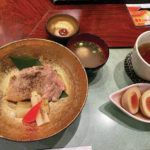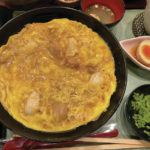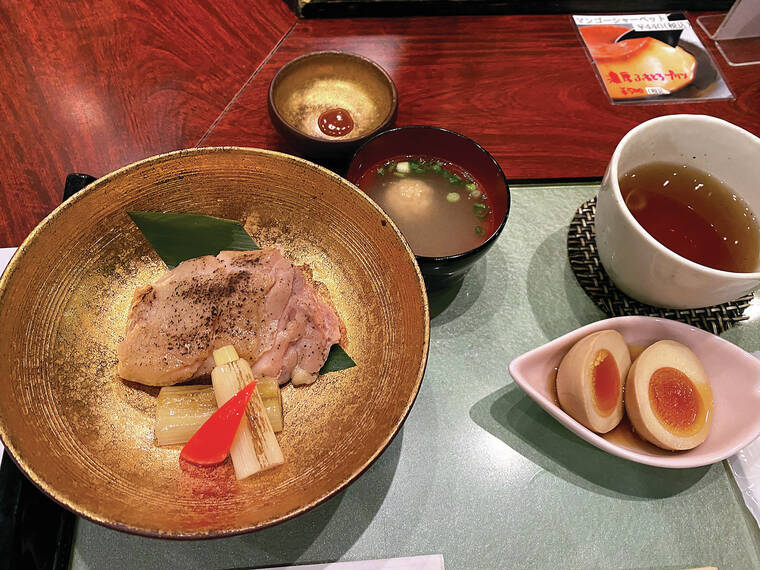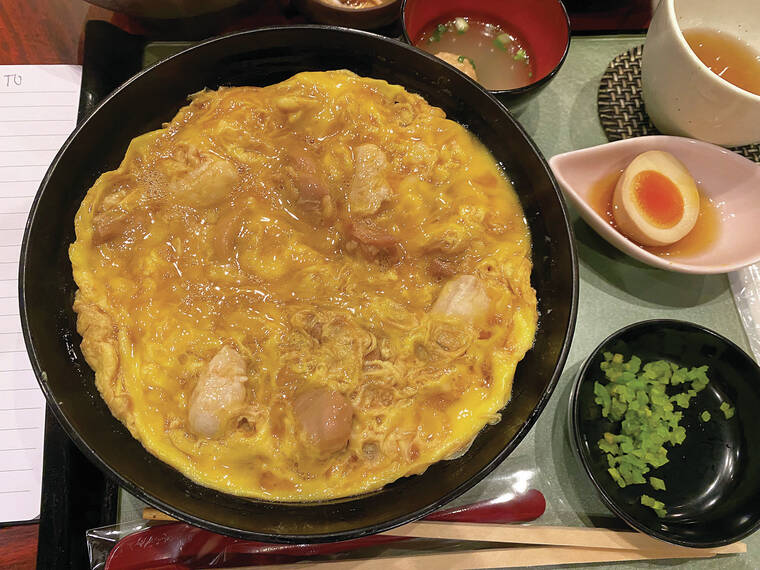Oyakodon, the most famous comfort food of Japan, was invented by a restaurant in Nihonbashi, Tokyo, called Tamahide. This would be the 10th year of Japan’s Horeki, or 1760, when Japan was still ruled by the Tokugawa shogunate dynasty. They were known as a restaurant for hot pot, with shamo or gamecock hot pot as their premier dish. “However, in the late 1800s, the wife of Tamahide’s fifth-generation owner noticed how some diners would take the last remaining remnants of their hot pot, pour it over a bowl of white rice, and mix it with an egg. Figuring that if customers liked it enough to make it themselves, the restaurant may as well save them the trouble, and in 1891, the 20th year of the Meiji era, Tamahide’s chefs prepared their first oyakodon.”
The literal translation of oyako means parent or “oya” and child or “ko.” This all-in-one bowl dish consists of chicken (the parent) and eggs (the child).
If you go shopping at a store with kitchen utensils, you will be sure to find an oyakonabe, made of stainless steel. However, at Tamahide, the pans are made from copper, which allows even heat conduction and even cooking of the egg.
At Tamahide, the shoyu broth is heated up in an oyakonabe before the pre-cooked chicken is added.
The chicken comes from two different species and a mixture of red meat from the thighs and white meat from the breast. In a separate bowl, the eggs are beaten with chopsticks and then added into the pan.
After the eggs are semi-cooked, it is poured onto a bowl of steaming hot rice and served. The waitress does not give you a choice of the egg doneness. It comes out all the same, with runny egg topping.
You can order the premium oyakodon with a special Nagoya Cochin chicken. It is a high quality cross of the native chicken of Nagoya and a variety from China known as the buff cochin. Typical of the Japanese, the standard of hygiene and chicken welfare is extraordinarily high. The chicken houses are layered with sawdust made from domestic cedar and mulberry trees. This chicken’s meat is firmer than usual, without the usual slightly slimy feel to it.
Here is the recipe for Tamahide’s famous oyakodon:
Tamahide
Oyakodon
Serves one
1/4 cup chicken thighs
1/4 cup chicken breasts
3 eggs and 2 egg yolks
Pot of dashi stock or chicken stock
Sukiyaki broth:
2 tablespoons dashi stock
2 teaspoons soy sauce
1 teaspoon mirin
1 teaspoon sugar
1 tablespoon sake
Cut the chicken into small bite-sized pieces.
Poach the chicken thighs and breast in a simmering pot of dashi or chicken stock for 2 to 3 minutes to lightly cook it.
To make the sukiyaki broth, mix all the broth ingredients together and bring to a boil. Cook off the alcohol and flambe the mixture.
Beat the eggs and egg yolks quickly with chopsticks.
Do not overbeat. The egg should not be uniform in color.
In a oyakonabe or if you do not have one, a frying pan, add in the sukiyaki broth, chicken and eggs and cook until the eggs are fluffy but still runny.
Slide the entire egg and chicken mixture carefully onto a bowl of hot rice.
Notes: The chicken can be poached in dashi or chicken stock to enhance its flavor compared to poaching it in water. You can poach the chicken in advance and store it in the refrigerator. You can also make the sukiyaki broth in advance.
• • •
Our dear friend Keiko and her son Leo took us to Tamahide Ichino at Solamachi Sky Town as the original restaurant in Nihonbashi is under renovation.
The oyakodon is made the same as the original restaurant.
There is a menu board out front and you need to make your selection and pay before entering.
There are only a few selections and most locals who go to eat know exactly what they want, order, and are seated. We were there before 11 a.m., when they opened, and yet, because we couldn’t decide whether to order the special chicken, the chicken with livers, or just with chicken, others ordered, paid, were seated, and filled up the restaurant so we had to wait another 20 minutes before we were able to get in.
When we finally got seated, a tray with cold green tea, a cup of chicken broth with a chicken meatball, a soft-cooked egg, and pickled vegetables were presented to us.
Drum roll … the oyakodon came a few minutes later.
It was as I expected, simple, clean flavors and delicious — unlike what I have seen here when I order oyakodon, with no bamboo shoots, long rice, or Chinese cabbage. Just a little onion, chicken and egg.
So if you like a hard-cooked egg, this is not the place for you. You can even order a raw egg on top of the oyakodon!
Foodie Bites
The Hawaii Community College’s Culinary Program’s The Cafeteria and Da ‘Ohana Cafe are open from 10:30 a.m. until 12:30 p.m. today through Thursday.
Call 808-934-2581 for Da ‘Ohana Cafe and 808-934-2559 for The Cafeteria to place your take-out orders.
Email Audrey Wilson at audreywilson808@gmail.com.









